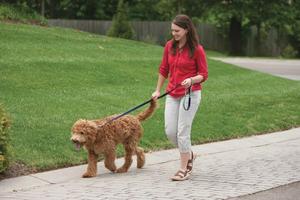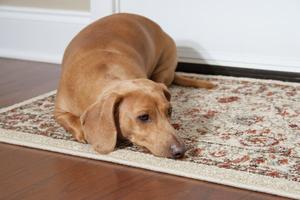There is no doubt that many people view their dogs as family members. In fact many of my clients often use the term "four-legged children" when describing their pets. A recent journal article in Science demonstrated that both people and their dogs experience an increase in the natural bonding hormone oxytocin after a period of interaction. Some researchers theorize the familiar canine characteristics of large eyes, playfulness, and retention of other juvenile traits promote a relationship similar to that of a parent and child. Although the interaction is often very strong and relatively peaceful, just like any other relationship, there can be periods of conflict.
One of the most common factors in canine aggression is miscommunication between people and the dog. Since pets fill a child-like role in our families, people commonly transpose ideas of child cognition and discipline onto pets and this inevitably leads to frustration or bigger problems. While I do not believe that pet owners cause their pets' aggression in most instances - many complex factors like genetics and early socialization go into that - knowing a few key facts about how animals learn is essential to preventing and treating canine aggression.
 Timing is the most crucial part of good communication with animals. We humans can refer to the past and future with words, and can therefore provide consequences for behavior a child performed several minutes or hours prior to the punishment or reward. I can tell my daughter in the afternoon that she does not get screen time now because she didn't clean up her mess earlier that morning. My words and her brain allow her to connect her action (or lack of action) in the morning with her punishment 8 hours later. However, my dog cannot understand that he is being reprimanded for chewing my shoe if I scold him while showing him the mangled sneaker he created even minutes before. His cognitive processes simply do not permit him to link the act of shoe chewing with the chewed up shoe. He can, however, connect the item with my angry response. This results in the "guilty" look, or the dog seeming very sheepish as I walk through the door before I knew there is a chewed up shoe in the house... even if the other dog was the culprit! Some very interesting studies by Horowitz Canine Cognition Lab at Barnard College demonstrated that the "guilty" look a dog shows when they have done something "wrong" is dependent on the owner's response and not the dog's behavior.
Timing is the most crucial part of good communication with animals. We humans can refer to the past and future with words, and can therefore provide consequences for behavior a child performed several minutes or hours prior to the punishment or reward. I can tell my daughter in the afternoon that she does not get screen time now because she didn't clean up her mess earlier that morning. My words and her brain allow her to connect her action (or lack of action) in the morning with her punishment 8 hours later. However, my dog cannot understand that he is being reprimanded for chewing my shoe if I scold him while showing him the mangled sneaker he created even minutes before. His cognitive processes simply do not permit him to link the act of shoe chewing with the chewed up shoe. He can, however, connect the item with my angry response. This results in the "guilty" look, or the dog seeming very sheepish as I walk through the door before I knew there is a chewed up shoe in the house... even if the other dog was the culprit! Some very interesting studies by Horowitz Canine Cognition Lab at Barnard College demonstrated that the "guilty" look a dog shows when they have done something "wrong" is dependent on the owner's response and not the dog's behavior.
This lack of understanding about canine cognition and poor timing of consequences is a major source of canine behavior problems. Consequences basically need to occur as the dog is performing the behavior in question to be effective. Aversive corrections are rarely recommended largely because of the common side effects. Corrections that occur even more than even one second late can have serious negative consequences because the person is delivering punishment at what seems like random times to the dog. The dog begins to feel uneasy or frightened by the erratic person and this can lead to more generalized anxiety and aggression. An owner that grabs a dog's collar to pull him over to the mess it made is very likely to have a dog that cowers, growls, or bites at other times the owner reaches down because the dog relates the reach to a previously unpleasant experience.
Because we are human and inevitably have inconsistent and poorly timed consequences, most behaviorists ask people to move away from aversive corrections. Aggressive behavior in our dogs does not require a forceful retaliation from us. Behaviorists focus on primarily changing the basic emotional connection between the dog and his target of aggression, thereby decreasing the dog's motivation for aggression, and not necessarily the aggressive behavior itself. Aversive correction can suppress behavior, but it will never help the animal feel more comfortable around the target.
One of the most common family-directed aggression scenarios that I help dog owners address is aggression towards children. Many attributes about children - erratic or fast movements, loud high-pitched voices, direct eye contact, and the tendency to hug - are frightening to dogs. Most of the dogs that growl, snap, or bite children give many unnoticed stress signals before the aggression. These may include lip licking, yawning, subtle or overt attempts to move away, and avoidance of eye contact. When these signals are not heeded, the dog often feels compelled to show overt aggression. Punishing the dog only strengthens the negative association between the dog and the child. The initial focus should be on devising a management plan to keep the dog happy and relaxed while preventing the child from inadvertently threatening or scaring the dog. For example, we may have the dog in the family room while the toddler is playing on the floor, but an indoor play yard/exercise pen separating the two (with an adult focused on dog and another on the child). We also teach the dog a few redirection cues to diffuse situations instead of relying on correction. Teaching "go to place," for example, is a great way to get a dog to move away from a fast-moving toddler.
Also, teaching children basic ways to interact with dogs is imperative. Even young children can start to understand petting the dog's chest with an open hand instead of hugging. We should never encourage children to lie or sit on top of dogs, no matter how cute or picture perfect it may look. Every parent and dog owner should see the website stopthe77.com created by The Family Pet. The title refers to the statistic that a family or friend's dog inflicts 77% of all dog bites to children. The majority of the bites were easily preventable with some basic education about canine body language.
In addition to straightforward fear-related aggression, another common motivation for aggression to family members is guarding resources such as the food bowl, high-value treats like rawhides, toys, resting places, and people. Traditionally behavior professionals have labeled this a dominance issue, and therefore rationalize the treatment must be the humans asserting dominance typically through forceful methods. However, in most instances, owners report the dogs showing the aforementioned stress and anxiety behaviors such as lip licking and avoidance of eye contact before the aggressive behavior. This is indicative of a dog feeling conflicted, not dominant. While I have had some reports of owner-directed aggression being "fixed" presumably by physically punishing the animal, I have many more cases in which this tactic was not only ineffective, but also resulted in serious injury to the owner when the dog reacted to the painful or frightening correction.
Efficacy AND safety are always a priority for veterinary behaviorists, so our treatment plans focus on avoidance and positive emotional connections with the family in all situations.
Avoidance:
- Most dogs with possessive aggression should not be given long-lasting animal-based products like rawhides, pig ears or bones.
- Dogs that are aggressive to people or dogs while on the couch or bed should be banished to the floor in most cases.
However, lasting change can be made by trying to replace negative expectations with good ones. This is called counterconditioning:
- Instead of simply petting, putting your hand in the food bowl, or taking the food bowl away while the dog is eating in an attempt to make the dog "get over" a person messing with her while eating, walk by the food bowl at a safe distance and drop in a tiny piece of chicken 2-3 times a meal.
- If a dog gets snarky when his sleep is disturbed, say his name and call him over to you for attention. That small change helps the dog feel more in control, less stressed, and very unlikely to show aggression.
- Don't chase down the dog when she steals an off-limit item. Instead, practice having your dog drop items on cue using positive reinforcement so she will pleasantly anticipate your approach.
For the best success and highest safety, families should always discuss the details with a qualified behaviorist who is educated in the science of emotion, not just the practice of dog training. Other areas of potential stress and overall health should also be addressed because these can affect every aspect of the dog's behavior and therefore the bond between people and their pets.
- Nagasawa M, Nagasa, Mitsui S, et al. Oxytocin-gaze positive loop and the coevolution of human-dog bonds. Science 2015;348:333-336.
- Horowitz A, Hecht J. Looking at Dogs: Moving from Anthropocentrism to Canid Umwelt. In: Domestic Dog Cognition and Behavior. Berlin, Heidelberg: Springer Berlin Heidelberg; 2014:201-219.





